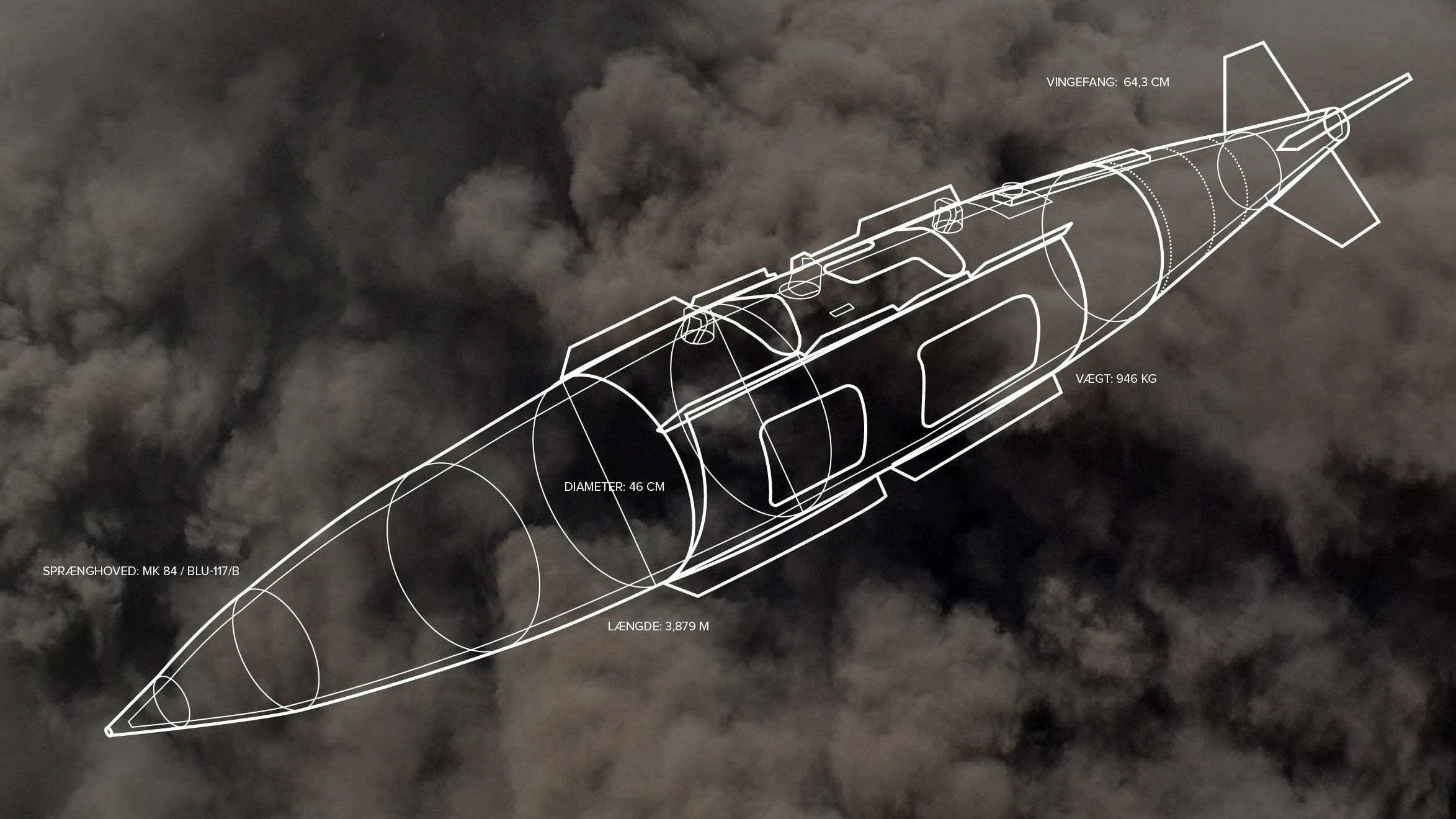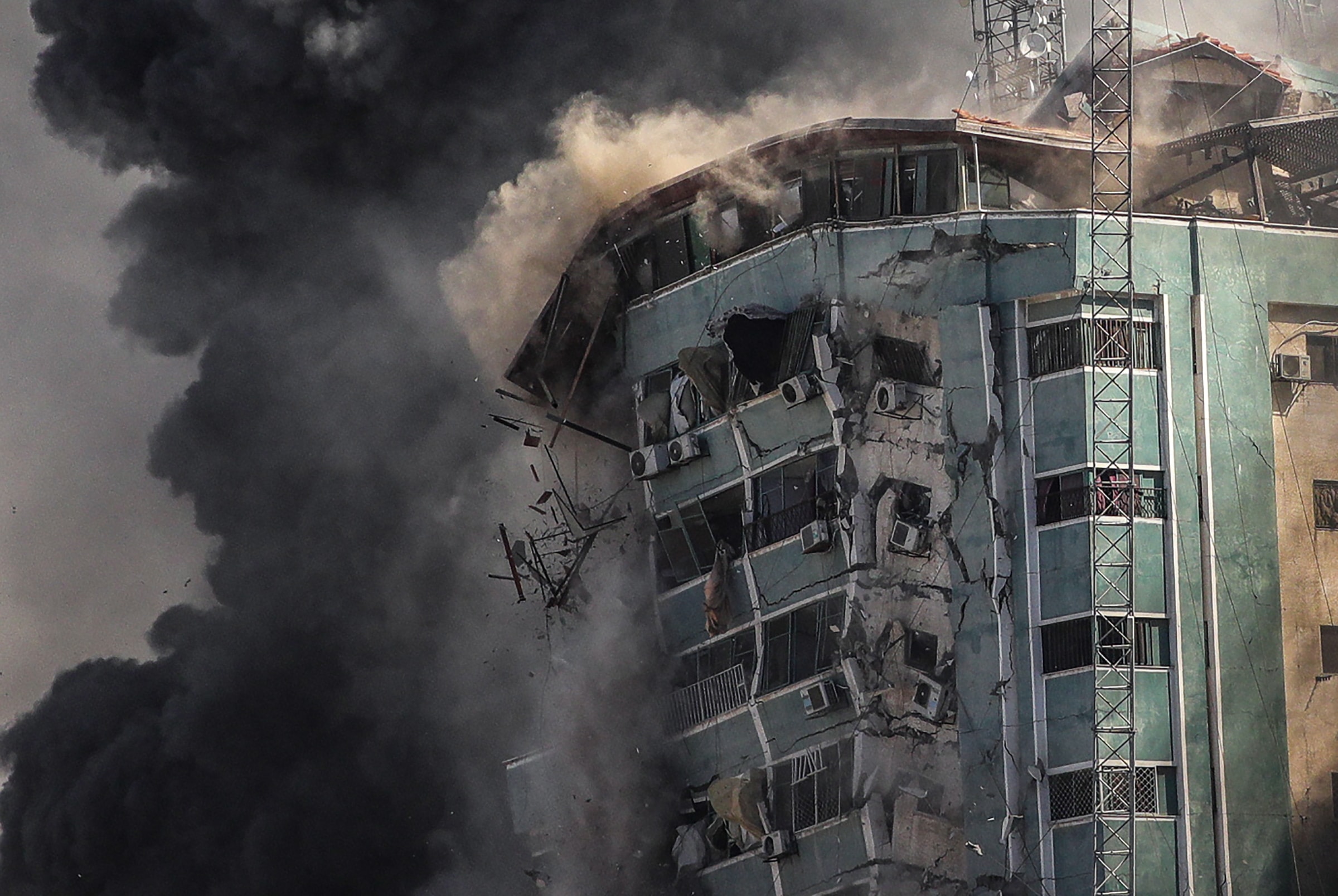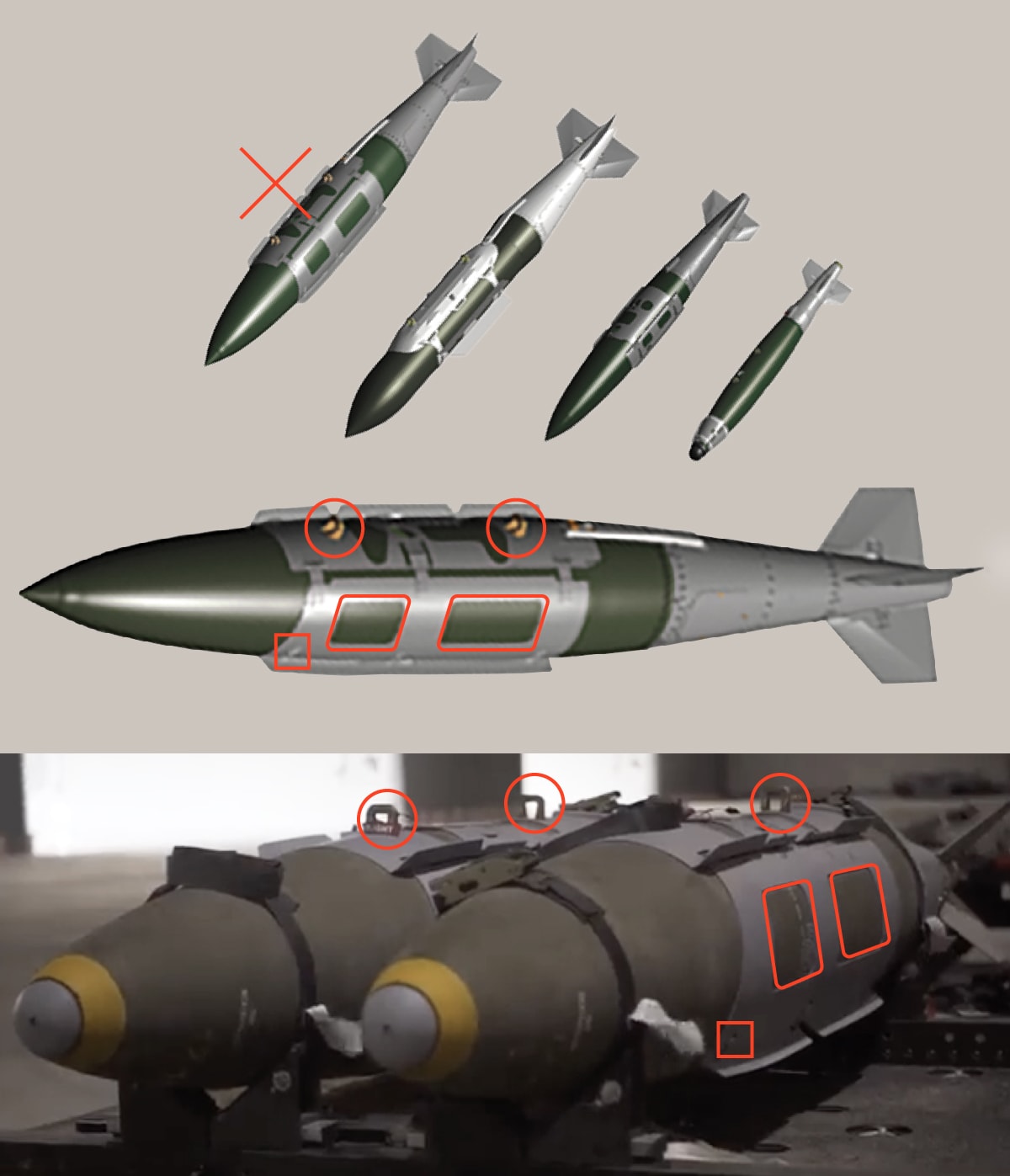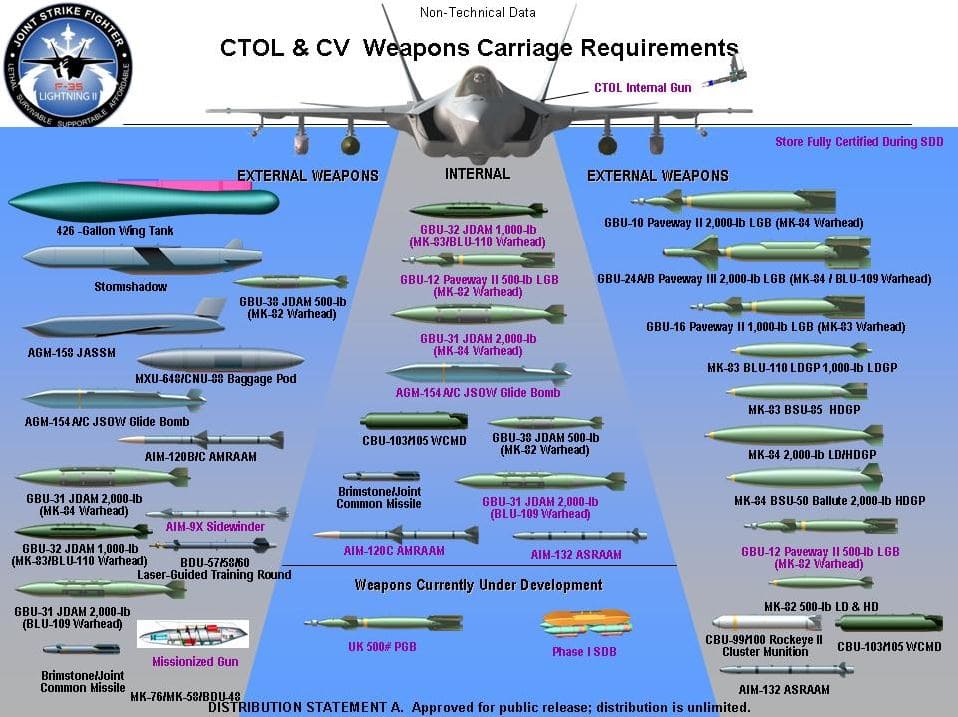


On 8 August 2022, the day Israel concluded its latest three-day bombing operation in Gaza, the Israeli Air Force posted a video on Twitter:
A brand new F-35 slowly rolls out of a hangar before a group of pilots appear to receive a briefing from a superior. Their uniforms reveal that they are from Israel’s “Lions of the South” squadron, and from the sparse audio in the video, you can tell that the briefing is about “combat action”. In the video, the fighter’s bomb bay is open, and at the end we see a series of bombs being prepared before an anonymous F-35 pilot dons his flight suit.
As Danwatch, Information and Lighthouse Reports have documented, Israeli F-35s, which contain a number of crucial Danish components from, among others, the Danish company Terma, took part in operations in Gaza in 2021 and 2022. Here, 75 children were killed and human rights organisations claim that Israel committed possible war crimes.
We have now taken a closer look at the bombs that appear to be loaded into the Danish-equipped aircraft. And we can document that these are the heavy GBU-31s, which are some of the most controversial bombs used by the Israeli military in Gaza.
At almost 1,000 kg, the GBU-31 is one of the heaviest bombs in the Israeli military’s active arsenal, and according to the International Red Cross, the bomb is so powerful that it should not be used in urban areas.
A UN Human Rights Council commission report cites engineers and arms designers that the blast wave from a GBU-31 “can rupture lungs and sinuses and tear off limbs hundreds of feet (30-90 metres) from the blast site.”
“When it hits, it generates [GBU-31] an 8,500-degree fireball, carving a 20-foot crater while displacing 10,000 pounds of dirt and rock and generating enough wind to knock down walls several blocks away and throw metal fragments a mile (1.6 kilometres ed.) or more,” the commission continues.
Yet Israel has regularly dropped bombs in Gaza, one of the world’s most densely populated areas with over 2 million inhabitants in an area the size of Langeland.
Over the past few years, GBU-31 has on several occasions caused entire residential complexes in Gaza to collapse, resulting in many civilian casualties. Amnesty International and Human Rights Watch have for years criticised Israel’s use of the GBU-31 bombs in Gaza and consider several of the bombings to be war crimes.
In 2015, the UN Commission assessed that Israel’s military risks violating the laws of war as soon as it uses the bomb in populated areas of Gaza: “Attacks using this type of arms in densely populated, built-up areas of Gaza would (…) likely constitute a violation of the prohibition on indiscriminate attacks,” the Commission wrote in its report to the UN Human Rights Council.

The manufacturer of the F-35 fighter aircraft, Lockheed Martin, states that the F-35A, which is Israel’s version of an F-35, keeps two GBU-31 bombs in its internal cargo hold as its “standard internal arms load”. And the Israeli Air Force states on its website that the F-35 can hold two GBU-31 bombs as its “standard configuration”.
Danwatch and Information have found that the same type of bomb seen in the August video appears in other images of Israeli F-35s. And we have gone through a long technical process to identify whether these are the heavy GBU-31 bombs.
With the help of reverse image searches on the internet and various military manuals, we were able to determine that this is a standard aerial bomb that has been converted with an external guidance system into a “smart bomb” that is guided towards the target using GPS. With technical assistance from the international research centre Lighthouse Reports, we were then able to determine the GBU-31 by visual comparisons of the external system.
FACTS
The outer guidance system that converts the bomb into a ‘smart bomb‘, which is guided towards the target using GPS, is manufactured by American Boeing. Boeing only markets four models of the guidance system, and visual comparisons show that the bomb in the Israeli Air Force video is the leftmost type – a GBU-31.

The Israeli Air Force video was posted on 8 August 2022, the day Israel’s Operation Breaking Dawn in Gaza ended, and in a commentary on the video, the Air Force states that the F-35s have just participated in the three-day bombing campaign. It has not been possible to determine which bombs were used over Gaza during the three-day offensive in August 2022, when at least 32 Palestinians, including eight children, were killed by Israeli air strikes.
However, we have evidence that Israel used the controversial bombs during the Gaza war in May 2021, where we know that the Danish-equipped F-35 fighter aircraft actively participated. Among other things, the bombs were used on 16 May in the deadliest attack of the war, when Israeli bombs caused three residential buildings to collapse, killing 44 civilians, including 18 children.
According to months of investigation by the New York Times and Human Rights Watch, the collapse of the residential buildings was most likely caused by four GBU-31 bombs dropped by Israeli aircraft on the road and pavement a few metres from the buildings.

According to the New York Times, Israeli authorities report that Israeli military attempted to hit the Hamas movement’s underground tunnel system, but Hamas turned out to have a larger underground command centre on site, causing the buildings along the road to collapse. However, Israel has not provided any evidence for this claim and Hamas denies that this is the case.
Amnesty International believes that the Israeli military should have anticipated “the potentially catastrophic consequences” of dropping such heavy bombs in such a densely populated area. And Human Rights Watch wrote in a report on the attack that “the use of high explosive munitions such as GBU-31 bombs in such a densely populated area caused foreseeable harm to civilians and civilian objects”.
The laws of war dictate that civilians must be warned if military infrastructure in their vicinity is attacked, but none of the residents of the buildings were warned, according to the New York Times and human rights organisations.
After lengthy investigations. both Amnesty International and Human Rights Watch consider the bombing to be a possible war crime, and Amnesty believes it should be part of an upcoming investigation of Israel by the International Criminal Court, ICC.
GBU-31 bombs were also used during other major attacks in May 2021. According to an investigation by Al Jazeera TV, it was most likely this type of bomb that was used when a 13-story media centre in Gaza was levelled during the war on 15 May 2021.
The media centre was home to the Associated Press news agency, Al Jazeera TV station and a number of other media outlets in Gaza, but Israel claims that the building also housed militants from the Hamas movement.
The Israeli military warned the owner of the building an hour before the bombing and no civilians were killed in the attack. However, both the Associated Press and the Committee to Protect Journalists condemned the bombing as an attack on press freedom in Gaza, and Reporters without Borders has called on the International Criminal Court (ICC) to investigate the attack as a war crime.
It has not been possible to say which Israeli aircraft dropped the bombs on 15 or 16 May 2021. Although we know that the Danish-equipped F-35s actively participated in the operation, several other Israeli fighter aircraft can also carry these bombs.
Danwatch and Information have asked the Israeli Defence Force, IDF, if their F-35 fighter aircraft carry GBU-31 bombs and if they have used the bombs in attacks in Gaza. They have not answered this question.
Israel’s use of the controversial GBU-31 bombs in Gaza has been criticised for many years before Israel took delivery of the F35 aircraft.
After the three-week war in Gaza in 2014, which claimed the lives of at least 1,462 Palestinian and 5 Israeli civilians, Israel was criticised by a commission established by the UN Human Rights Council for using GBU-31 in Gaza.
The UN Commission assessed that “however accurate the bomb is, it remains highly questionable whether a weapon with such a wide impact area allows its operators to adequately distinguish between civilians and civilian targets and the military targets of the attack when used in densely populated areas.”
The Commission concluded that the use of the GBU-31 in densely populated, built-up areas of Gaza is likely to constitute a violation of the prohibition on indiscriminate attacks. ‘Indiscriminate attacks’ refers to attacks that do not distinguish between military and civilian targets, which is prohibited and can be a war crime under international law.
This assessment is shared by Katharine Fortin, Senior Lecturer in International Law and Human Rights at Utrecht University, who specialises in international law during armed conflict.
She emphasises that it is a cardinal principle of international humanitarian law that belligerent parties distinguish between legal, military targets and illegal, civilian targets. That’s why international law prohibits the use of arms that are inherently indiscriminate, for example because they are inaccurate or incapable of being directed.
“But the law also prohibits belligerents from using arms that, while not indiscriminate, have an indiscriminate effect because of the circumstances in which they are used,” she says.
“When explosives with a wide impact area are used in a densely populated area, there is a high chance that they will be rendered indiscriminate and therefore illegal.”
Although Israel’s GBU-31 is a “smart bomb” that is guided relatively accurately with GPS, it can still act randomly because it is so powerful.
Katharine Fortin adds that the use of explosive arms with such a large impact area in a densely populated area also risks violating two other important rules of international law; that you must always take care to spare the civilian population and civilian objects when planning attacks, and that an attack should not be carried out if the civilian casualties are expected to be too high in relation to the direct military advantage sought.
Defence giant Terma and a number of other Danish companies have received orders worth more than DKK 3.7 billion to supply military equipment to F-35 fighter manufacturer Lockheed Martin, which has so far delivered 36 F-35 aircraft to Israel out of a total of 50 ordered by the country. According to military experts, several of the Danish-produced parts are crucial for the aircraft to be fully operational, and Terma has, among other things, supplied the pylons – or weapon stations – that hold and launch the aircraft’s external bombs and missiles.
The pylons are removable, and in the Israeli Air Force video of the GBU-31 bombs, the pylons are not on the F-35 aircraft, whose internal bomb bay is open. However, according to an overview from the US Air Force F-35 programme, the state-of-the-art fighter aircraft can also carry GBU-31 bombs remotely under its wings.

Neither Terma nor Lockheed Martin have responded to our inquiries as to whether it is the Danish-made pylons that hold – and drop – the mega-bombs. But two photos from the US military show GBU-31 bombs hanging under the wings of an F-35 aircraft in what look like Terma’s pylons:
Danwatch found two photos in Israeli media and on the Israeli Air Force’s Facebook page of Israeli F-35s with what appear to be Danish-made pylons loaded with bombs. In both cases, however, the bombs are not GBU-31s.
Violations of the laws of war in Gaza have been happening for so many years that Denmark should have foreseen that Danish equipment could be involved, says Omar Shakir, Israel and Palestine Director at Human Rights Watch. He says that the discovery of GBU-31 bombs is yet another argument in favour of Denmark completely suspending deliveries to Israeli F-35s.
“In Gaza, there are more than 2.1 million people in a 40 by 11 kilometre strip of land. And the Israeli practice has been to frequently drop high-explosive arms in densely populated areas here in ways that have been documented as disproportionate and have led to civilian casualties,” he says.
“This history of violations of international law should be understood by those who want to do business with the Israeli military. It is a long-standing practice of the Israeli government and one that clearly has huge civilian consequences.”
Danwatch has previously shared an Israeli news report in which an anonymous F-35 pilot describes what it is like to bomb in Gaza, one of the world’s most densely populated areas with 2.1 million people in an area the size of Langeland:
“In Gaza, you’re never happy about having to attack. You say to yourself: ‘I to do my job precisely and I must not make any mistakes’. It’s the last place in the world where you should make mistakes,” he says.
You can read more about the Danish-equipped F-35 missions in Gaza here: